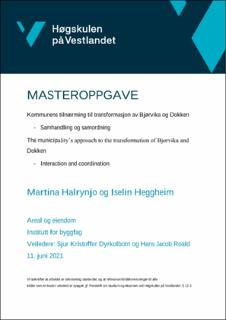| dc.contributor.author | Halrynjo, Martina Sophia | |
| dc.contributor.author | Heggheim, Iselin | |
| dc.date.accessioned | 2021-08-10T11:53:22Z | |
| dc.date.available | 2021-08-10T11:53:22Z | |
| dc.date.issued | 2021 | |
| dc.identifier.uri | https://hdl.handle.net/11250/2767199 | |
| dc.description | Masteroppgave i areal og eiendom.
Fakultet for ingeniør- og naturvitskap/ Institutt for byggfag/ Høgskulen på Vestlandet, campus Bergen. | en_US |
| dc.description.abstract | Historisk sett har havnen vært av stor betydning for de viktigste havnebyene, det var havnen som skapte byen og ikke omvendt. Etter den industrielle revolusjonen fikk havnen en annen innplassering i byen, både fysisk og organisatorisk. I nyere tid har samhandling og samordning blitt en grunnsten i føringene for hvordan man ønsker byutvikling. Dette henger blant annet sammen med behovet for bærekraftig utvikling gjennom fortetting og transformasjon av industri- og havneområder til moderne byområder. Denne oppgaven skal undersøke hvordan kommunen har gått frem for transformasjon av havnearealene i Bjørvika og Dokken. Oppgaven baserer seg på to caseområder; Bjørvika i Oslo og Dokken i Bergen. For å belyse denne hovedproblemstillingen, har vi utarbeidet fire delproblemstillinger; hvordan har kommunen tilnærmet seg havnevesenet, hvordan har kommunen tilnærmet seg Statens vegvesen (SVV), hvordan har kommunen lagt til rette for samhandling og samordning og hvilken rolle har kommunen for gjennomføring ved transformasjon av Bjørvika og Dokken. Studien er gjennomført med kvalitative tilnærmingsmåter. Det ble gjennomført intervju av åtte sentrale aktører.
De to caseområdene er tilnærmet like, men skiller seg i tid og rom og har ulike premisser for samhandling og samordning. Bjørvika er i siste gjennomføringsfasen og er ansett som en vellykket byutvikling, mens Dokken er i startfasen. På bakgrunn av studien kan det konkluderes med at de to kommunene har gått ulikt frem for transformasjon av Bjørvika og Dokken. Kommunenes tilnærming til havnevesenet skiller seg i det forstand at man i Oslo klarte komme frem til en felles løsning til fordel for en ny bydel og ny havn. I Bergen har det vært flere utfordringer som kommunen har måtte løse for å kunne starte en transformasjonsprosess. Videre ser man at de institusjonelle rammene for samhandling og samordning mellom kommune og havnevesenet, som kommunal sektormyndighet, skiller seg fra de institusjonelle rammene for samhandling og samordning mellom kommune og SVV som statlig sektormyndighet. Videre har Oslo kommune inntatt en tydeligere rolle i planprosessen til Bjørvika, enn det en kan se Bergen kommune har gjort på Dokken så langt. Bergen kommune valgte derimot å gå inn i prosjektet med åpnere prosesser i et forsøk på å dele eierskapet til prosessen med mange, mens i Oslo har disse prosessene blitt oppfattet som mer lukket. | en_US |
| dc.description.abstract | Historically, the port has been of great importance to the most important port cities, it was the port that created the city and not the other way around. After the industrial revolution, the port was given a different location in the city, both physically and organisationally. In recent times, collaboration and coordination has become a foundation in the strategies for desired urban development. This is partly related to the need for sustainable development through densification and transformation of industrial and port areas into modern urban areas. This thesis will investigate how the municipality has proceeded for the transformation of the port areas in Bjørvika and Dokken. This thesis is based on two case-areas: Bjørvika in Oslo and Dokken in Bergen.
To enlighten the main problem, we have prepared four sub-problems; how has the municipality approached the port authority, how has the municipality approached the Norwegian Public Roads Administration, how has the municipality facilitated collaboration and coordination and what role does the municipality have for implementation in the transformation of Bjørvika and Dokken. This study had a qualitative approach. Interviews were conducted with eight key informants.
The two areas in this study are almost identical but differ in time and space and have different premises for collaboration and coordination. Bjørvika is in the final implementation phase and is considered as a successful urban development, while Dokken is in the start of the developing phase. Based on this study, it can be concluded that the two municipalities have proceeded differently for the transformation of Bjørvika and Dokken. The municipalities' approach to the port authority differs in the sense that in Oslo they managed to reach a common solution in favour of a new district and a new port.
In Bergen, there have been several challenges that the municipality has had to solve to be able to start the transformation process. Furthermore, it can be seen that the institutional framework for cooperation and coordination between the municipality and the Port Authority, as a municipal sector authority, differs from the institutional framework for cooperation and coordination between the municipality and the Norwegian Public Roads Administration as a state sector authority. However, Oslo municipality has taken on a clearer role in the planning process for Bjørvika compared with what Bergen municipality has done at Dokken so far. Bergen municipality, on the other hand, chose to enter the project with more open processes in an attempt to share ownership of the project with many, while in Oslo these processes is perceived as more closed. | en_US |
| dc.language.iso | nob | en_US |
| dc.publisher | Høgskulen på Vestlandet | en_US |
| dc.rights | Navngivelse 4.0 Internasjonal | * |
| dc.rights.uri | http://creativecommons.org/licenses/by/4.0/deed.no | * |
| dc.title | Kommunens tilnærming til transformasjon av Bjørvika og Dokken - Samhandling og samordning | en_US |
| dc.title.alternative | The municipality’s approach to the transformation of Bjørvika and Dokken - Interaction and coordination | en_US |
| dc.type | Master thesis | en_US |
| dc.description.localcode | MOA300 | en_US |

